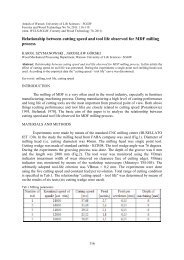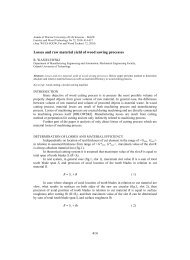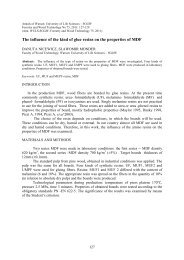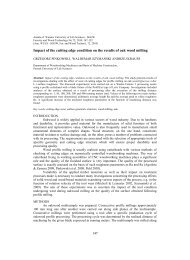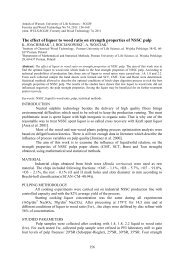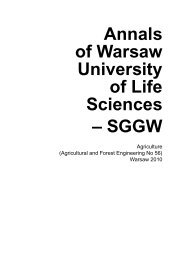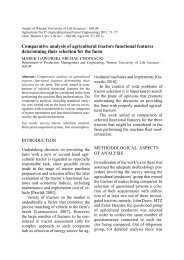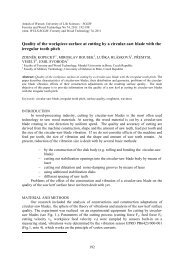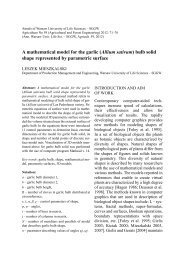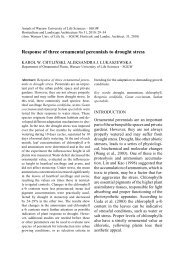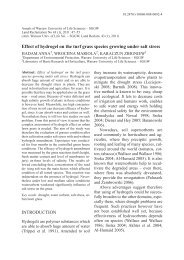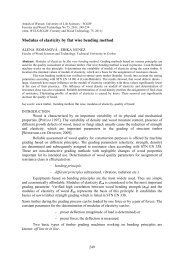Physical-acoustical characteristics of maple wood with wavy structure
Physical-acoustical characteristics of maple wood with wavy structure
Physical-acoustical characteristics of maple wood with wavy structure
You also want an ePaper? Increase the reach of your titles
YUMPU automatically turns print PDFs into web optimized ePapers that Google loves.
a) b) c)<br />
Fig. 1 Cutting layout for preparing test specimens<br />
<strong>Physical</strong>-acoustic <strong>characteristics</strong> were assessed <strong>with</strong> the aid <strong>of</strong> our own measuring<br />
equipment RESONATOR – designed at the Department <strong>of</strong> Physics, Electronics and Applied<br />
Mechanics <strong>of</strong> the Technical University in Zvolen (Fig. 2). The underlying principle is<br />
described in KUBOVSKÝ (2007). The equipment served for measuring resonance frequency f r<br />
(frequency corresponding to the maximum oscillation angle recorded by the recorder) and<br />
frequencies f 1 and f 2 (corresponding to 50% maximum oscillation angles right and left from f r ).<br />
In the following, we used Equations (1 and 2) for obtaining the speed <strong>of</strong> propagation <strong>of</strong><br />
longitudinal wave c, and acoustic constant A. The modulus <strong>of</strong> elasticity E was calculated<br />
according to the equation<br />
2 2<br />
E 4l<br />
f r<br />
<br />
w<br />
, (4)<br />
where l is the specimen’s lengths and f r is resonance frequency corresponding to k = 0.<br />
Wood density corresponding to given moisture content was obtained from the rate <strong>of</strong> the test<br />
specimen’s mass and volume (STN 490108). Moisture content was measured gravimetrically,<br />
following the Standard STN 490103.<br />
<br />
Fig. 2 Computer-controlled equipment RESONATOR <strong>with</strong> DDS: computer, 2 – electronic modulus, 3 – acoustic<br />
modulator 4 – test specimen, 5 – scanner, 6 – digital scale, 7 – digital appliance for measuring specimen dimensions<br />
(KUBOVSKÝ 2007).<br />
RESULTS AND DISCUSSION<br />
The results are summarised in Table 1. All the values relate to a moisture content <strong>of</strong> 11.3 %<br />
– the moisture content <strong>of</strong> the test specimens after conditioning.<br />
Wood density for w-<strong>maple</strong> <strong>wood</strong> ranged from 600 to 685 kgm –3 , meaning significantly<br />
higher values than for c-<strong>maple</strong>. These values meet the criteria set by RAJAN (1998) for highquality<br />
<strong>wood</strong> in violin making. The density values <strong>of</strong> c-<strong>maple</strong> were <strong>with</strong>in 520–630. As such,<br />
they did not reach the values required for violin back plates. Our average density values for<br />
c-<strong>maple</strong> are in accord <strong>with</strong> the results reported by RAJAN (1998) and KURJATKO et al. (2010).<br />
Wood density primarily depends on the morphology and number <strong>of</strong> fibres. The<br />
morphology <strong>of</strong> fibrous cells in <strong>maple</strong> <strong>wood</strong> shows a number <strong>of</strong> atypical features. Maple fibres<br />
are thin-walled. With more than 70 % <strong>of</strong> diameter owing to lumen, <strong>maple</strong> <strong>wood</strong> should be<br />
14



